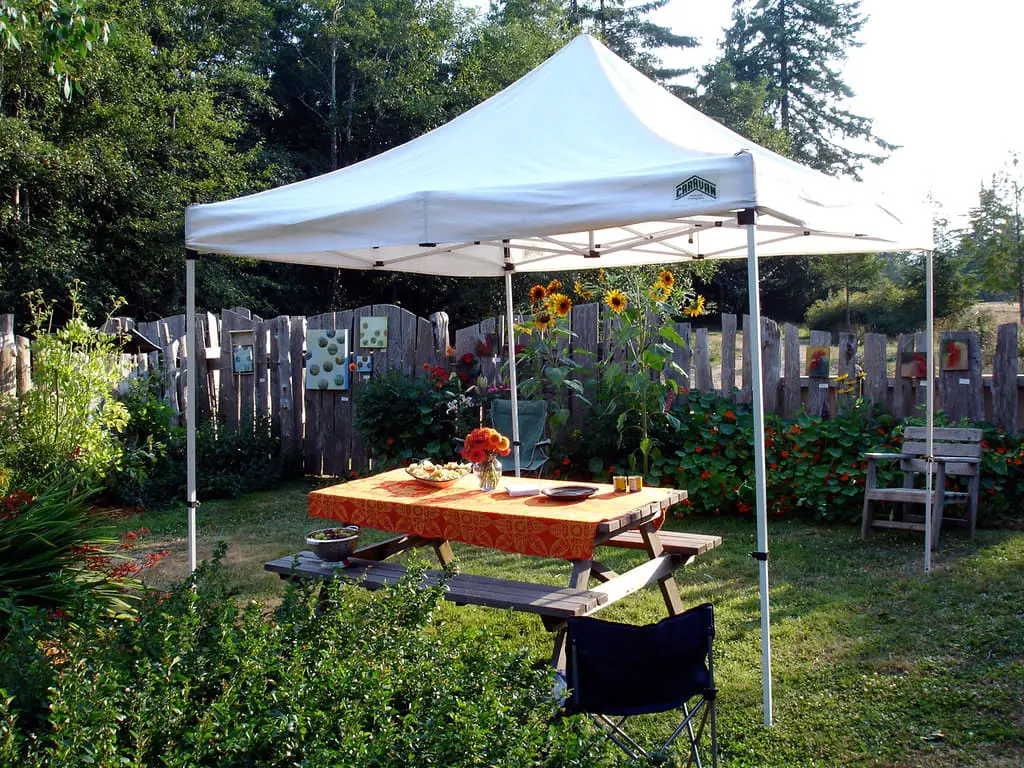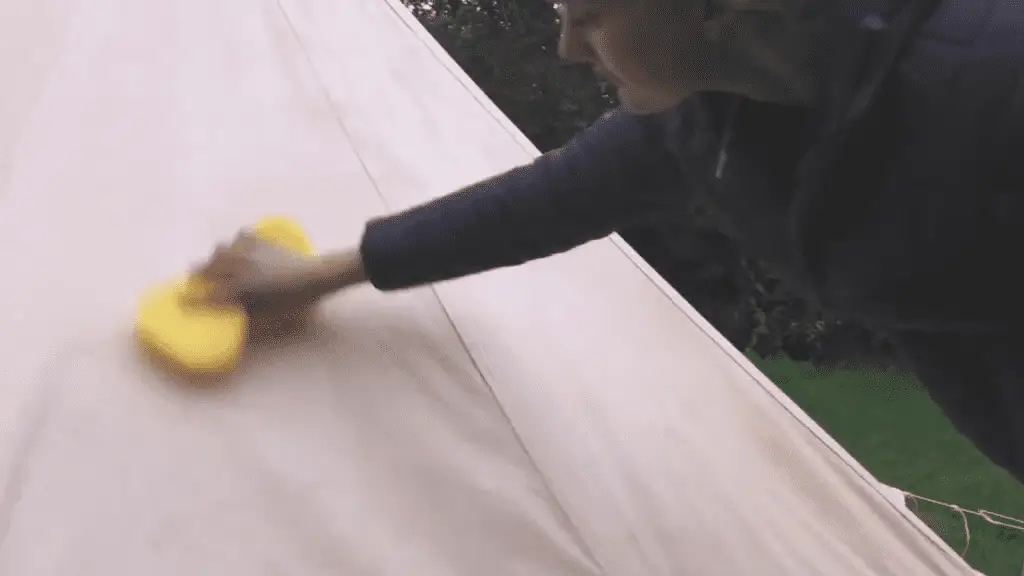If you have a fabric gazebo canopy in your outdoor living space, it’s essential to maintain and protect it so that it stays in excellent condition for years to come.
I’ve found that following a few simple steps can help ensure that my gazebo canopy looks new and functions well over time. First, it’s crucial to regularly clean the canopy using a soft-bristled brush and mild detergent, then rinse with water.
Additionally, applying a fabric protectant can help safeguard against damage caused by UV rays and moisture. To maintain the canopy, I inspect it regularly for any signs of wear and tear, and I store it during the off-season.
By sticking to a consistent cleaning and maintenance routine, I can ensure that my fabric gazebo canopy provides reliable shelter from the elements and lasts for many seasons to come.
How to Clean and Maintain a Fabric Canopy Gazebo: To keep my fabric gazebo canopy in good condition, I wipe away marks immediately and remove sap and debris promptly. I wash the canvas with soapy water and a soft brush, then hose it down and let it dry completely before storing it away.
How to Clean and Maintain a Fabric Canopy Gazebo?
Just like you wouldn’t use a harsh cleaning solution on your baby’s delicate skin, you should treat your tent with care. Experts recommend using non-abrasive sponges or rags and a non-detergent soap to clean your tent.
It’s important to avoid using too much water and to never use household cleaners like harsh dish soaps, bleach, spot removers, or laundry pre-soaking products.
By following these tips, you can ensure that your tent stays clean and in good condition for many camping trips to come.
How to make your Canopy Tent last longer: Important tips.
Keep it in a cool, dry place to prevent mould and mildew from growing on the canopy. Make a designated space for your tent, and avoid putting anything on top of it to prevent damage to the canopy or frame. How long a tent lasts depends on how well you take care of it, so proper maintenance is key.
Inspect your Tent for Damage.

When you clean your tent, it’s a great time to check for any damage. Before starting the cleaning process, examine your tent for any tears or holes.
You can do this by looking for air bubbles when the tent is wet. If you find any damage, you can repair it before it becomes a bigger issue. Check out our blog on how to fix a ripped canopy if you find a tear.
Clean on a Non-Abrasive Surface.
To avoid damaging your tent canopy, it’s important to protect it from debris and abrasive surfaces like gravel or asphalt. You can do this by laying down a drop cloth before cleaning. If you don’t have a drop cloth, make sure to clean your tent on a soft surface that won’t scratch or damage the material. This will help prevent tears, holes, and dirt buildup.
Avoid Excess Weight on Truss Bars.
It’s important to avoid putting extra strain on your event tent, as this can affect its overall lifespan. To prevent damage, don’t pour water on or wash your tent without taking it apart first. Also, try not to add too much weight to truss bars when decorating your tent, as this can cause extra strain and potentially damage the tent.
Limit Commercial Washer Use.
Using commercial washers is not recommended for cleaning outdoor canopies, as harsh chemicals can damage the tent. Instead, you can make your cleaning solution and use gentle washing methods to keep the tent materials in good condition. This will help ensure that your canopy lasts for a long time.
Store only When Dry.
If you store a wet tent, it can cause mildew, mould, and rust to grow on it, which can damage it. Therefore, it is essential to dry your tent completely before storing it. Even if your tent is mildew, mould, and rust-resistant, it can still be damaged if stored while wet.
Never Use a Brush for Cleaning.

Using brushes to clean your tent can be harmful to the tent material, as they are abrasive. Instead, it is advisable to use soft materials like cloths, rags, and mops to clean your canopy and frame. These tools will help you get rid of dirt and grime from your event tent without causing any damage.
How to Clean Your Tent: Step-by-Step Guide
Here are some steps to clean your tent that are very important. We are discussing all steps below:
To Shield Your Gazebo Canopy from Weather Damage
To keep your gazebo canopy in good condition, it’s crucial to protect it from the elements. You should shield it from the sun, rain, and other weather conditions that can damage the fabric.
To protect it from the sun, you can use a spray that blocks UV rays and prevents the fabric from fading. To keep it dry and prevent mould and mildew growth, you can use a waterproofing spray to protect it from the rain.
Water Damage:
To prevent water from seeping into your gazebo canopy, you can use a waterproofing solution that comes in a spray. This solution can be applied to the fabric to create a protective layer against water. Always read the instructions that come with the solution you are using and ensure that it is safe for the fabric of your gazebo canopy.
UV Light Damage:
To protect your fabric gazebo canopy from sunlight, you can apply a spray that is designed to resist UV rays. This spray will create an extra layer of protection for the canopy and can be reapplied whenever needed.
You can also use a canopy cover to provide additional protection for the canopy when it is not being used. The cover will help to keep the sunlight and other elements away from the canopy, keeping it in good condition for longer.
Scheduling Professional Cleaning and Maintenance for Your Canopy
To keep your gazebo canopy in good condition, it’s important to have it professionally cleaned and maintained. This will remove any dirt, grime, and debris from the fabric and identify any potential issues. A professional cleaner can also advise you on how to protect and maintain your gazebo canopy.
Regular Cleaning of Your Gazebo Canopy
Regularly cleaning your gazebo canopy is important to keep it in good condition. This helps remove dirt and dust that can damage the fabric and cause fading.
You can use a mild detergent and a soft brush to scrub the fabric and rinse it with water. Let it air dry before storing or using it again. You should clean it at least twice a year to keep it in good shape.
Check the fabric for any damage before cleaning and avoid using harsh chemicals or cleaning solutions. By taking care of your gazebo canopy, it will last longer and you will enjoy it for many years.
Proper Storage of Your Gazebo Canopy
It’s important to store your gazebo canopy properly when you’re not using it to protect it from damage and keep it in good condition. To do this, you should fold it neatly and store it in a dry, cool place, away from dampness, humidity, and direct sunlight.
Properly folding your gazebo fabric can make it easier to set up and take down. To do this, start by taking down the gazebo and cleaning the fabric.
Then, lay the fabric on a flat surface and fold it in half lengthwise, then in half again widthwise. Finally, fold the fabric into quarters and roll it up tightly, securing it with a tie or band and storing it in a cool, dry place.
Materials Needed
Here are the materials you’ll need to clean and maintain a fabric canopy gazebo:
Soft-Bristled Brush:
A soft-bristled brush is an essential tool for cleaning a fabric canopy gazebo. It is gentle enough to use on the fabric without causing damage, yet strong enough to remove dirt, debris, and stains. When using a soft-bristled brush, be sure to use gentle, circular motions to avoid damaging the fabric.
Mild Detergent:
A mild detergent is also needed for cleaning a fabric canopy gazebo. Avoid using harsh chemicals or bleach, as these can cause damage to the fabric. Instead, use a gentle, mild detergent that is specifically designed for use on outdoor fabrics.
Water Hose:
A water hose is necessary for rinsing off the fabric after cleaning it with a mild detergent and soft-bristled brush. Make sure to use a gentle spray setting to avoid damaging the fabric.
Spray Bottle:

A spray bottle can be used to apply fabric protection to the canopy gazebo. Fabric protectant helps to prevent water, dirt, and other debris from sticking to the fabric, which can help to prolong the lifespan of the canopy.
Fabric Protectant:
A fabric protectant is an important tool for maintaining the quality of a fabric canopy gazebo. It helps to protect the fabric from UV rays, water damage, and other outdoor elements. Be sure to choose a fabric protectant that is specifically designed for use on outdoor fabrics.
Ladder or Step Stool (If needed):
A ladder or step stool may be necessary to reach the top of the gazebo canopy. When using a ladder or step stool, be sure to follow proper safety precautions to avoid accidents or injury.
FAQs:
Q:1 What is the process for cleaning a fabric gazebo top?
Dip a soft-bristled brush into the soapy water and gently scrub the canopy to remove mildew and stains. Use a sponge for stubborn areas and rinse the cover thoroughly after cleaning.
Q:2 How can you waterproof a fabric gazebo?
First, clean the canopy and apply seam sealer. Then, remove any previously applied waterproof coating and spray the entire tent with waterproof spray. Let it dry completely.
Q:3 Can a fabric gazebo be left up all year?
No, it’s not recommended to leave a gazebo canopy up all year due to adverse weather conditions that can cause irreparable damage such as stretching or tearing of the canvas and uplift from strong winds.
Q:4 Is it okay to leave a fabric gazebo up during the winter?
Yes, depending on the type of cover it has and whether it’s a hard top or a soft top, a gazebo can be left up during the winter.
Q:5 What is the process for storing a gazebo canopy for the winter?
Before storing, deep clean the frame, canopy, and sidewalls. Make sure the canvas is completely dry and follow the instructions for proper storage.
Conclusion:
In conclusion, taking care of your fabric canopy gazebo is crucial to ensure its longevity and maintain its appearance. Regular cleaning using mild detergent and a soft-bristled brush can help to prevent mildew and stain build-up, while waterproofing can protect the fabric from water damage.
It is also important to store your gazebo properly during the winter months to avoid damage from harsh weather conditions. By following these simple steps, you can enjoy your fabric canopy gazebo for many years to come.
We hope you will be well aware of how to clean and maintain a fabric canopy gazebo, after reading this comprehensive guide. If you have any questions, please feel free to comment below!


F*ckin’ awesome things here. I am very glad to see your article. Thanks so much and i’m having a look ahead to contact you. Will you please drop me a e-mail?